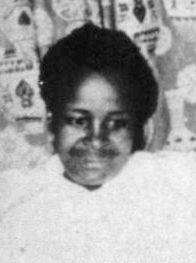
Rhodesia, officially from 1970 the Republic of Rhodesia, was an unrecognised state in Southern Africa from 1965 to 1979, equivalent in territory to modern Zimbabwe. Rhodesia was the de facto successor state to the British colony of Southern Rhodesia, which had been self-governing since achieving responsible government in 1923. A landlocked nation, Rhodesia was bordered by South Africa to the south, Bechuanaland to the southwest, Zambia to the northwest, and Mozambique to the east. From 1965 to 1979, Rhodesia was one of two independent states on the African continent governed by a white minority of European descent and culture, the other being Apartheid South Africa.

Zimbabwe, officially the Republic of Zimbabwe, is a landlocked country in Southern Africa, between the Zambezi and Limpopo Rivers, bordered by South Africa to the south, Botswana to the southwest, Zambia to the north, and Mozambique to the east. The capital and largest city is Harare, and the second largest is Bulawayo.

Southern Rhodesia was a landlocked self-governing British Crown colony in southern Africa, established in 1923 and consisting of British South Africa Company (BSAC) territories lying south of the Zambezi River. The region was informally known as south Zambesia until annexed by Britain at the behest of Cecil Rhodes's British South Africa Company, for whom the colony was named. The bounding territories were Bechuanaland (Botswana), Northern Rhodesia (Zambia), Moçambique (Mozambique), and the Transvaal Republic.

White Zimbabweans are Zimbabwean people of European descent. In linguistic, cultural, and historical terms, these Zimbabweans of European ethnic origin are mostly English-speaking descendants of British settlers and a small minority of them are either Afrikaans-speaking descendants of Afrikaners from South Africa and/or those descended from Greek and Portuguese immigrants.

The Zimbabwe National Army (ZNA) is the primary branch of the Zimbabwe Defence Forces responsible for land-oriented military operations. It is the largest service branch under the Zimbabwean Joint Operations Command (JOC). The modern army has its roots in the Rhodesian Army, which was raised between 1963 and 1964 after the breakup of the Federation of Rhodesia and Nyasaland. A Joint High Command created in March 1980 to oversee integration of the formerly belligerent Rhodesian Security Forces, Zimbabwe African National Liberation Army (ZANLA), and the Zimbabwe People's Revolutionary Army (ZIPRA) officially established the Zimbabwe National Army in late 1980, nearly a year after the end of the Rhodesian Bush War.
Godfrey Guwa Chidyausiku was a Zimbabwean judge and politician. He was involved in politics during Rhodesia's unilaterally declared independence, being a member of the Rhodesian House of Assembly.
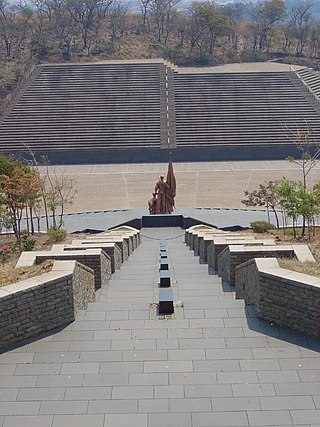
National Heroes Acre or simply Heroes Acre is a burial ground and national monument in Harare, Zimbabwe. The 23-hectare (57-acre) site is situated on a ridge seven kilometres from Harare, towards Norton. Its stated purpose is to commemorate Patriotic Front guerrillas killed during the Rhodesian Bush War, and contemporary Zimbabweans whose dedication or commitment to their country justify their interment at the shrine. Persons buried here are considered heroes by the incumbent Zimbabwe African National Union – Patriotic Front regime, which has administered the country since independence at 1980. Indeed, most of the recipients of the 'hero status' were known to be Zanu-PF sympathisers.
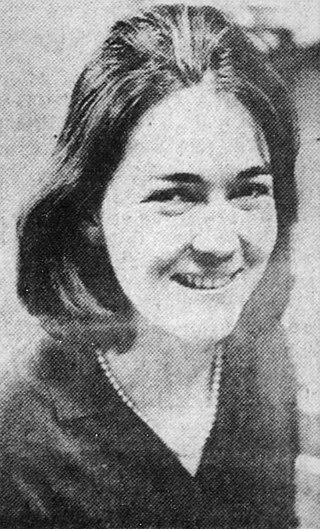
Judith Todd is the second daughter of Garfield Todd (1908–2002), Rhodesian Prime Minister 1953-58, and a political activist regarding Zimbabwe. She was married to Richard Acton from 1974 to 1984. Todd was born at Dadaya Mission in Rhodesia. She was educated at Queen Elizabeth Girls School. Her missionary father, Reginald Stephen Garfield Todd, served as Prime Minister of Southern Rhodesia between 1953 and 1958. Her mother, Jean Grace Wilson Todd, designed and implemented the Southern Rhodesian African Educational System.
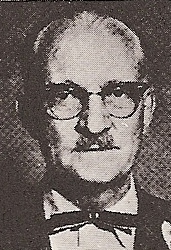
Desmond William Lardner-Burke was a politician in Rhodesia.

The history of the Jews in Zimbabwe reaches back over one century. Present-day Zimbabwe was formerly known as Southern Rhodesia and later as Rhodesia.
Abortion in Zimbabwe is available under limited circumstances. Zimbabwe's current abortion law, the Termination of Pregnancy Act, was enacted by Rhodesia's white minority government in 1977. The law permits abortion if the pregnancy endangers the life of the woman or threatens to permanently impair her physical health, if the child may be born with serious physical or mental defects, or if the fetus was conceived as a result of rape or incest. Nevertheless, an estimated 70,000+ illegal abortions are performed in Zimbabwe each year, resulting in around 20,000 maternal deaths.
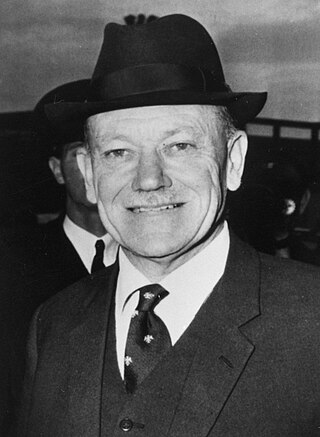
Sir Thomas Hugh William Beadle, was a Rhodesian lawyer, politician and judge who served as Chief Justice of Southern Rhodesia from March 1961 to November 1965, and as Chief Justice of Rhodesia from November 1965 until April 1977. He came to international prominence against the backdrop of Rhodesia's Unilateral Declaration of Independence (UDI) from Britain in November 1965, upon which he initially stood by the British Governor Sir Humphrey Gibbs as an adviser; he then provoked acrimony in British government circles by declaring Ian Smith's post-UDI administration legal in 1968.

Madzimbamuto v Lardner-Burke and another [1969] 1 AC 645 is a decision of the Judicial Committee of the Privy Council on United Kingdom constitutional law and the constitutional law of Rhodesia. The case was brought by Stella Madzimbamuto, to challenge the detention of her husband, Daniel Madzimbamuto, by the government of Rhodesia. The case raised the issue of the legality of the Unilateral Declaration of Independence made by Rhodesia in 1965. The case is often cited in relation to the legal status of constitutional conventions in United Kingdom constitutional law.
The Commander of the Zimbabwe Defence Forces is Chief of the Zimbabwe Defence Forces and the national defence organisations.
Bennie GoldinQC was a Byelorussian-born, Zimbabwean lawyer and judge. He was a justice of the Supreme Court of Zimbabwe from 1980 to 1981. Previously, he served on the High Court of Rhodesia from 1964 to 1980. Born in Nesvizh, Byelorussia, he grew up in Cape Town, immigrated to Salisbury after World War II, and later returned in 1981 to Cape Town where he served as a judge in Transkei.
The Baptist Convention of Zimbabwe is a Baptist Christian denomination in Zimbabwe. It is affiliated with the Baptist World Alliance and the Evangelical Fellowship of Zimbabwe. The headquarters is in Gweru.

Relations between the UK and Zimbabwe have been complex since the latter's independence in 1980. The territory of modern Zimbabwe had been colonised by the British South Africa Company in 1890, with the Pioneer Column raising the Union Jack over Fort Salisbury and formally establishing company, and by extension, British, rule over the territory. In 1920 Rhodesia, as the land had been called by the company in honour of their founder, Cecil Rhodes, was brought under jurisdiction of the Crown as the colony of Southern Rhodesia. Southern Rhodesia over the decades following its establishment would slowly be populated by large numbers of Europeans emigrants who came to form a considerable diaspora, largely consisting of Britons but also smaller groups of Italians, Greeks and Afrikaners. A settler culture that had already existed since the time of company would come to cement fully and the white population began to identify as Rhodesians, often in conjunction with British/Afrikaner/Southern European identities of their ancestors. Southern Rhodesia would go on to participate heavily in both the First and Second wars, providing soldiers and military equipment to the British war effort. During the years after the war, the relationship between Britain and Southern Rhodesia became increasingly strained. The UK had opted to decolonise Africa and had adopted a firm policy of no independence before majority rule, which deeply upset the white establishment of the colony, in particular the radical Rhodesian Front party led by Winston Field and later, Ian Smith. Relations between the British Government and the colonial Southern Rhodesian government deteriorated for much of the early 1960s and negotiations between the two dragged on with little to no success. Eventually, relations broke down entirely and Southern Rhodesia unilaterally declared independence from Britain. The move was met with zero recognition from the international community and the UK government and the illegitimate state was still formally considered under British sovereignty for its roughly 15-year span of existence. For the first 5 years of its proclaimed independence, Rhodesia still declared loyalty to the Queen Elizabeth II as a would-be Commonwealth realm, but this was never recognised by the British monarch who continued to encourage Smith's illegal government to resign. Given her refusal to appoint a Governor-general, from 1965 to 1970 an "Officer Administering the Government" served as the de facto head of state. Rhodesia eventually moved to sever all links with Britain and became a republic with a president in 1970. Throughout the subsequent Rhodesian Bush War between white Rhodesians and black paramilitaries such as ZANU and ZAPU, the UK continued to remain staunchly opposed to the rogue state and extensively sanctioned it, even enforcing blockades using the Royal Navy to cut off Rhodesian oil imports via Portuguese Mozambique. When Rhodesia failed to hold out after 15 years of fighting and came to the negotiating table with the black resistance groups and moderate African nationalist parties, the UK again became directly involved in Rhodesia's affairs. After a brief stint as the nation of Zimbabwe Rhodesia following an Internal Settlement that was denounced by the international community for not being satisfactory enough, the nation transiently reverted to its status as a self-governing British colony before being granted full independence and majority rule as Zimbabwe in 1980 under the landmark Lancaster House Agreement.

Zimbabwean nationality law is regulated by the Constitution of Zimbabwe, as amended; the Citizenship of Zimbabwe Act, and its revisions; and various international agreements to which the country is a signatory. These laws determine who is, or is eligible to be, a Zimbabwean national. The legal means to acquire nationality, formal legal membership in a nation, differ from the domestic relationship of rights and obligations between a national and the nation, known as citizenship. Nationality describes the relationship of an individual to the state under international law, whereas citizenship is the domestic relationship of an individual within the nation. Commonwealth countries often use the terms nationality and citizenship as synonyms, despite their legal distinction and the fact that they are regulated by different governmental administrative bodies. Zimbabwean nationality is typically obtained under the principal of jus sanguinis, i.e. by birth to parents with Zimbabwean nationality. It can be granted to persons with an affiliation to the country, or to a permanent resident who has lived in the country for a given period of time through registration, a process known elsewhere as naturalisation.

Daniel Nyamayaro Madzimbamuto (1929–1999) was a Southern Rhodesian activist who became a Zimbabwean politician and administrator.
